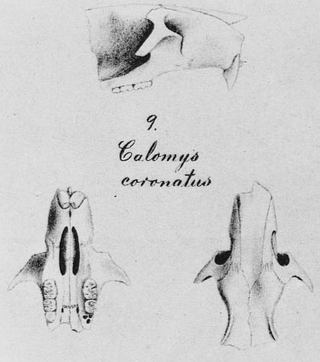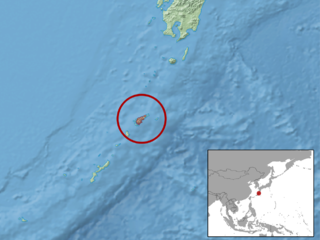The golden viscacha rat or golden vizcacha rat is the single species of the genus Pipanacoctomys of the rodent family Octodontidae. It has 92 chromosomes and has been regarded as tetraploid. This octodontid and its sister-species, the plains viscacha rat, may have arisen from the diploid mountain viscacha rat, as a result of the doubling and subsequent loss of some chromosomes. However, some genetic studies have rejected any polyploidism in mammals as unlikely, and suggest that amplification and dispersion of repetitive sequences best explain the large genome size.

Euryoryzomys emmonsae, also known as Emmons' rice rat or Emmons' oryzomys, is a rodent from the Amazon rainforest of Brazil in the genus Euryoryzomys of the family Cricetidae. Initially misidentified as E. macconnelli or E. nitidus, it was formally described in 1998. A rainforest species, it may be scansorial, climbing but also spending time on the ground. It lives only in a limited area south of the Amazon River in the state of Pará, a distribution that is apparently unique among the muroid rodents of the region.

Euryoryzomys russatus, also known as the russet oryzomys, russet rice rat, or big-headed rice rat, is a species of rodent in the family Cricetidae. It is a member of the genus Euryoryzomys, which was split off from Oryzomys in 2006. It was first described by Johann Andreas Wagner in 1848. It is found in southern Brazil, eastern Paraguay and northeastern Argentina. It is considered a large species in its genus, with a reddish-brown coat, long tail length, and large skull. It is a terrestrial rodent, spending its time foraging for seeds, fruits, and insects. It is listed by the IUCN as least concern, although studies have shown it to be influenced by anthropogenic disturbances. Predators consist of small members of the order Carnivora.

Oligoryzomys nigripes, also known as the black-footed colilargo or the black-footed pygmy rice rat, is a rodent in the genus Oligoryzomys of family Cricetidae. Oligoryzomys nigripes is a species that has been further divided into different sister taxa throughout history. It is found in different countries in South America. It is a large species with long ears, dark yellow to dark brown upperparts, sharply delimited from the whitish underparts, and often a pink girdle on the chest. This species of rat spends much of its life among the trees. The karyotype is 2n = 62, FNa = 78–82.
Pearson's chaco mouse is a species of rodent in the family Cricetidae. This mouse is found in the Gran Chaco ecoregion of southeastern Bolivia and western Paraguay at elevations up to 400 m. The species is named after American zoologist Oliver Payne Pearson. Its karyotype has 2n = 76 and 78 in the two subspecies. The latter is the highest diploid number of any species in the tribe Phyllotini.
The aquatic rat, Ecuador fish-eating rat, fish-eating rat or Ecuadoran ichthyomyine is a South American species of semiaquatic rodent in the family Cricetidae. It is the only species in the genus Anotomys. This species is currently considered endangered. It is thought to be nocturnal and feeds on aquatic arthropods and insects. It is found in small ranges along the Andes.

The crab-eating rat is a species of semiaquatic rodent in the family Cricetidae. It is found in Colombia, Ecuador, and Venezuela. Its natural habitats are rivers and swamps.

Ichthyomys is a genus of semiaquatic Neotropical rodents in the family Cricetidae. It contains the following species:

Stolzmann's crab-eating rat is a species of rodent in the family Cricetidae. It is found in Ecuador and Peru. The species is believed to be nocturnal and semiaquatic, and has been found at an elevation range of 900 to 1700 m. A survey in 2010 indicates that it is becoming a nuisance at local trout farms in the Peruvian puna.
The Ethiopian forest brush-furred rat or golden-footed brush-furred rat, is a species of rodent in the family Muridae. It is endemic to Ethiopia where its natural habitat is subtropical or tropical moist montane forests. It is threatened by habitat loss.

The Middle East blind mole-rat is a species of rodent in the family Spalacidae.

Muennink's spiny rat or Okinawa spiny rat is a species of rodent in the family Muridae. Endemic to Okinawa Island, Japan, its natural habitat is subtropical moist broadleaf forest. The karyotype has 2n = 44. Its sex chromosomes are abnormally large, while the other two species in Tokudaia have lost their Y chromosome. It is found only on the northern part of the island, above 300 m, and is thought to inhabit an area of less than 3 km2.

The Ryukyu spiny rat is a species of rodent in the family Muridae. Endemic to Amami Ōshima island in the Amami Islands of the Ryukyu archipelago of Japan, its natural habitat is subtropical moist broadleaf forest. The karyotype has an odd diploid number, 2n = 25. Like its relative T. tokunoshimensis, it has lost its Y chromosome and SRY gene.
The mountain viscacha rat or mountain vizcacha rat, historically viscacha rat or vizcacha rat, is a species of rodent in the family Octodontidae. It is endemic to Argentina.

The plains viscacha rat, plains vizcacha rat, red viscacha rat, or red vizcacha rat is a species of rodent in the family Octodontidae native to Argentina. It is one of three species in the genus Tympanoctomys.

Octodontidae is a family of rodents, restricted to southwestern South America. Fourteen species of octodontid are recognised, arranged in seven genera. The best known species is the common degu, Octodon degus.
The caatinga vesper mouse is a rodent species in the family Cricetidae from South America. It is endemic to eastern Brazil, where it is found in open savanna (cerrado) and thorny scrub (caatinga) habitats. Its karyotype has 2n = 66 and FN = 68. It was formerly synonymized with C. callosus, but the latter has 2n = 50 and FN = 66. Karyologic analysis of C. expulsus has shown that the X chromosome is large and submetacentric while the Y chromosome is either acrocentric or submetacentric. Predators include the barn owl. Sexual dimorphism in shape and size occurs; the former is present mainly before the age of 20 days. Males are smaller before age 50 days and larger thereafter, which becomes less prominent after 200 days.
The delicate salt flat mouse is a sigmodontine rodent species in the family Cricetidae from South America. It is the only species in the genus Salinomys. Its habitat is scrublands bordering salt flats in the Monte Desert area of central western Argentina at elevations around 400 m. The closest relatives of the species are the chaco mice (Andalgalomys).

The Tokunoshima spiny rat is a rodent found only on the island of Tokunoshima in the Satsunan Islands of Japan. Due to its small habitat, it is considered endangered. It is commonly found in the secondary and primary subtropical moist broadleaf forests of this island. The karyotype has an odd diploid number, 2n = 45. Like its relative T. osimensis, it is one of the few mammals that lack a Y chromosome and SRY gene.
The 2000s witnessed an explosion of genome sequencing and mapping in evolutionarily diverse species. While full genome sequencing of mammals is rapidly progressing, the ability to assemble and align orthologous whole chromosomal regions from more than a few species is not yet possible. The intense focus on the building of comparative maps for domestic, laboratory and agricultural (cattle) animals has traditionally been used to understand the underlying basis of disease-related and healthy phenotypes.











